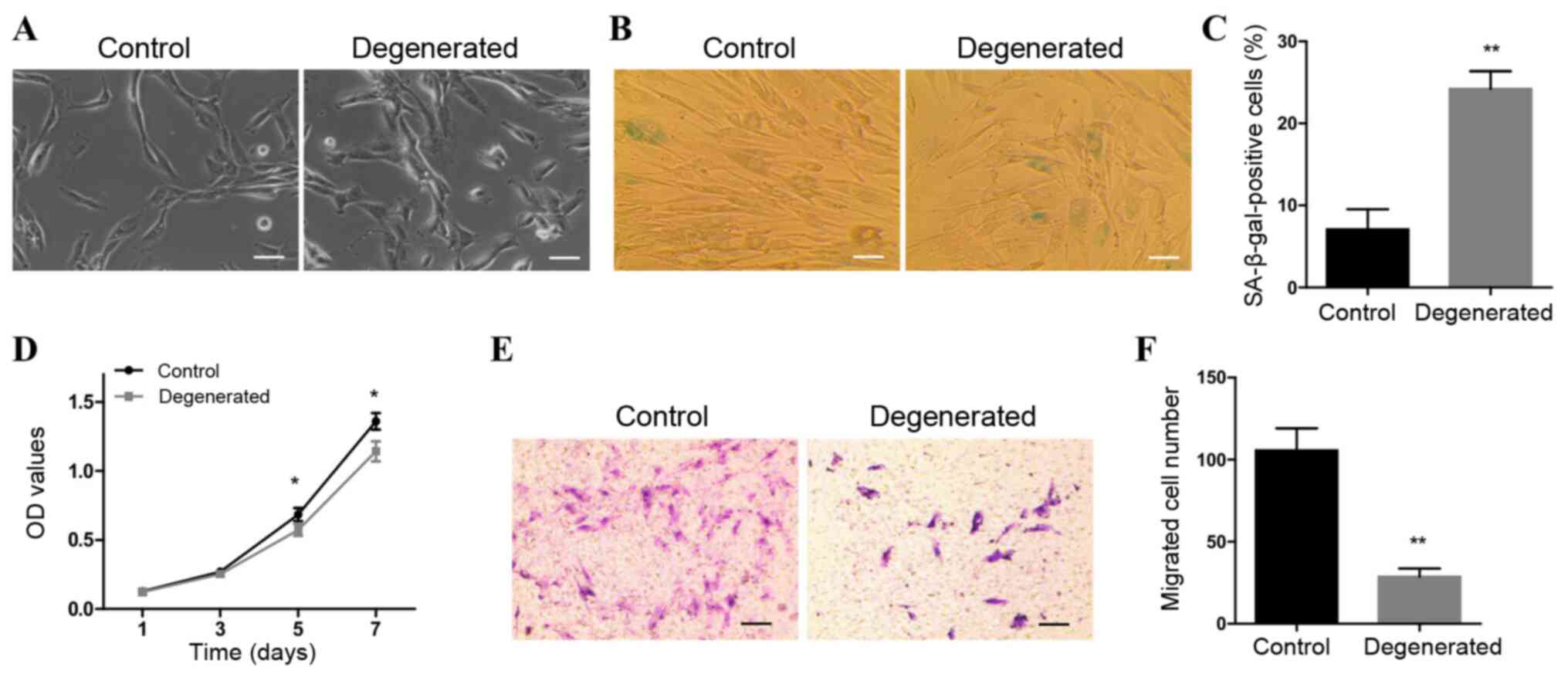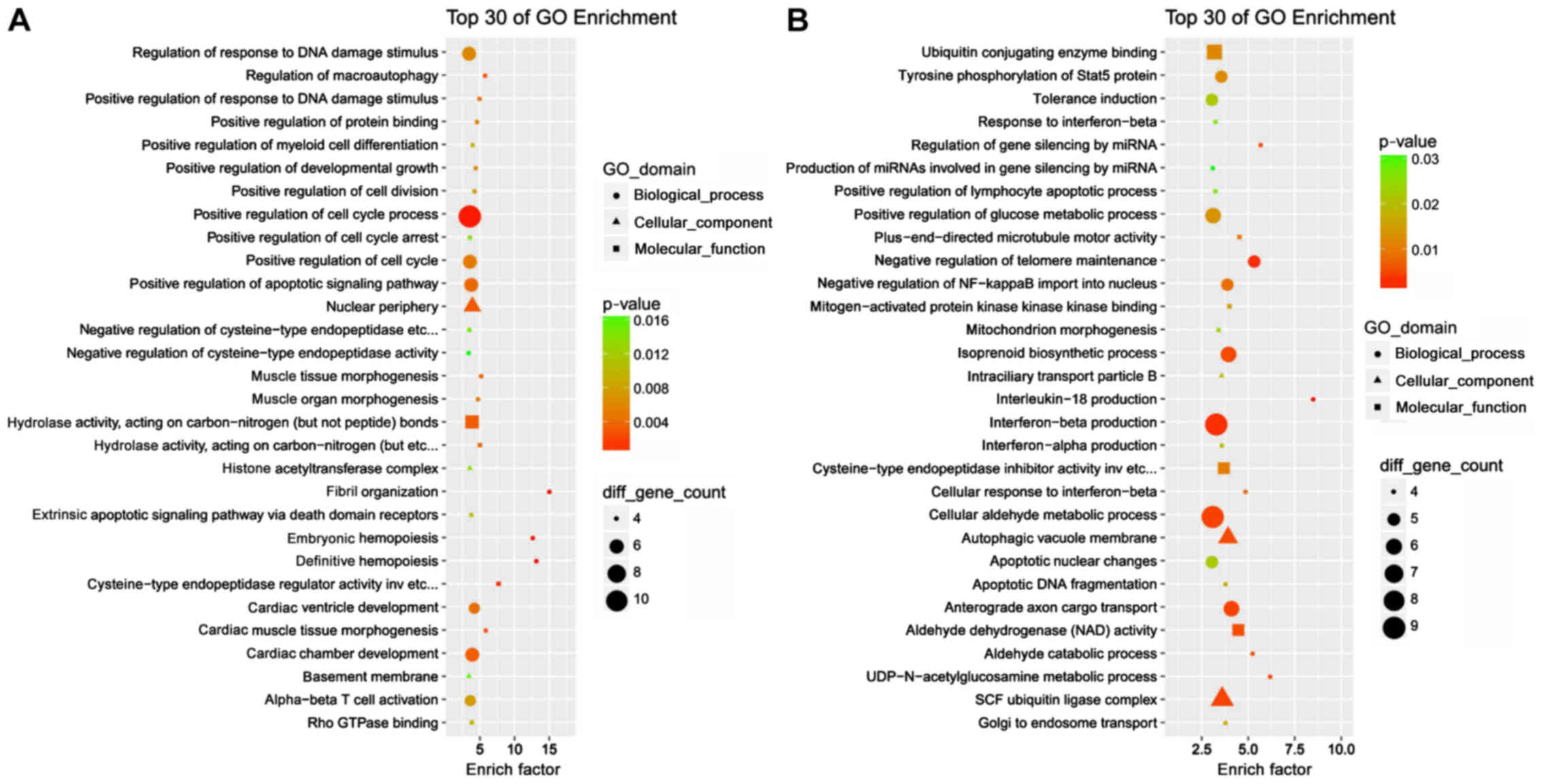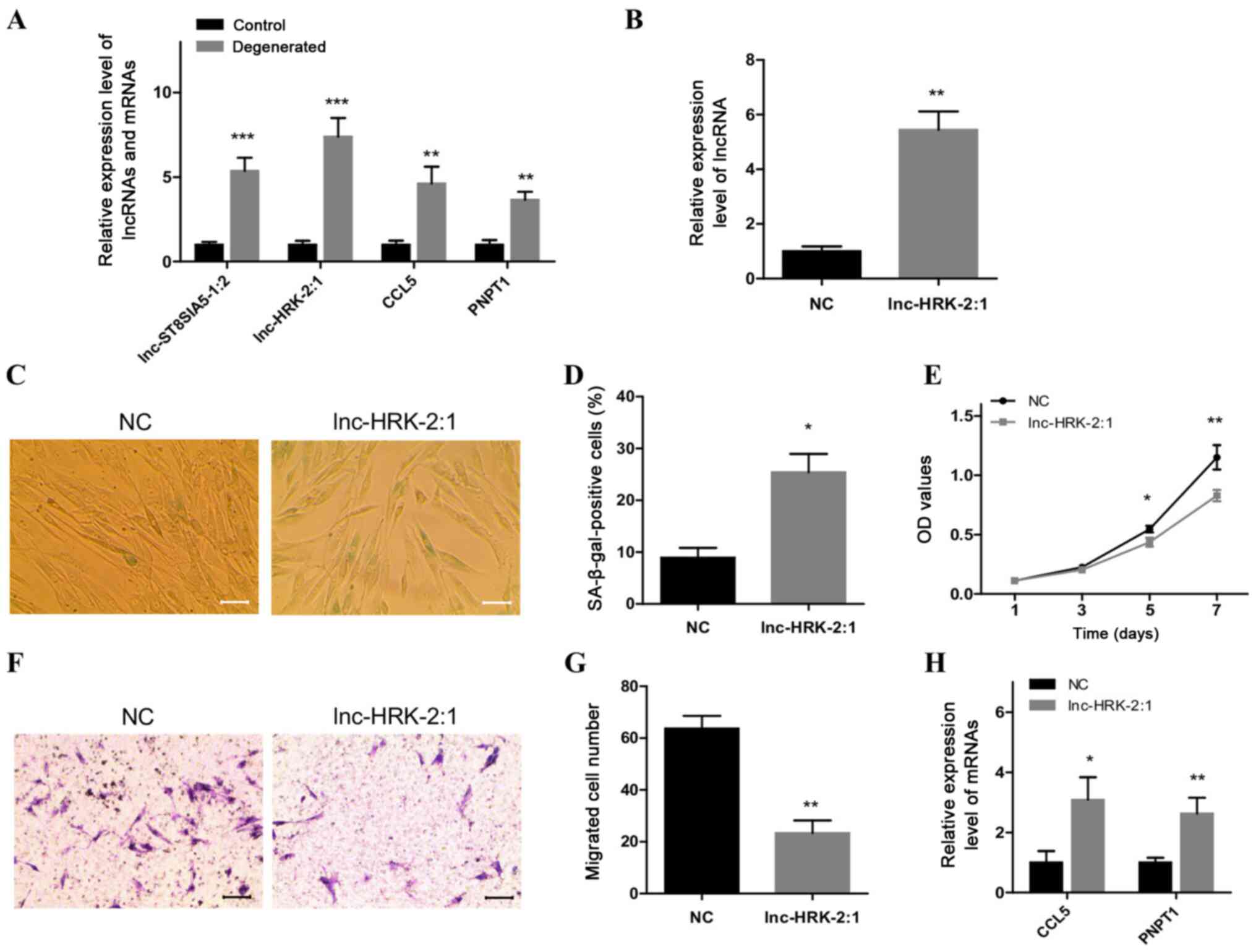|
1
|
Wang F, Cai F, Shi R, Wang XH and Wu XT:
Aging and age related stresses: A senescence mechanism of
intervertebral disc degeneration. Osteoarthritis Cartilage.
24:398–408. 2016.PubMed/NCBI
|
|
2
|
Katz JN: Lumbar disc disorders and
low-back pain: Socioeconomic factors and consequences. J Bone Joint
Surg Am. 88 (Suppl 2):S21–S24. 2006.
|
|
3
|
Colombier P, Clouet J, Hamel O, Lescaudron
L and Guicheux J: The lumbar intervertebral disc: From embryonic
development to degeneration. Joint Bone Spine. 81:125–129.
2014.PubMed/NCBI
|
|
4
|
Sampara P, Banala RR, Vemuri SK, Av GR and
Gpv S: Understanding the molecular biology of intervertebral disc
degeneration and potential gene therapy strategies for
regeneration: A review. Gene Ther. 25:67–82. 2018.PubMed/NCBI
|
|
5
|
Feng C, Liu H, Yang M, Zhang Y, Huang B
and Zhou Y: Disc cell senescence in intervertebral disc
degeneration: Causes and molecular pathways. Cell Cycle.
15:1674–1684. 2016.PubMed/NCBI
|
|
6
|
Le Maitre CL, Freemont AJ and Hoyland JA:
Accelerated cellular senescence in degenerate intervertebral discs:
A possible role in the pathogenesis of intervertebral disc
degeneration. Arthritis Res Ther. 9:R452007.PubMed/NCBI
|
|
7
|
Gruber HE, Ingram JA, Norton HJ and Hanley
EN Jr: Senescence in cells of the aging and degenerating
intervertebral disc: Immunolocalization of senescence-associated
beta-galactosidase in human and sand rat discs. Spine (Phila Pa
1976). 32:321–327. 2007.PubMed/NCBI
|
|
8
|
Kepler CK, Ponnappan RK, Tannoury CA,
Risbud MV and Anderson DG: The molecular basis of intervertebral
disc degeneration. Spine J. 13:318–330. 2013.PubMed/NCBI
|
|
9
|
Cheng S, Li X, Lin L, Jia Z, Zhao Y, Wang
D, Ruan D and Zhang Y: Identification of aberrantly expressed genes
during aging in rat nucleus pulposus cells. Stem Cells Int.
2019:27852072019.PubMed/NCBI
|
|
10
|
Ben-Porath I and Weinberg RA: The signals
and pathways activating cellular senescence. Int J Biochem Cell
Biol. 37:961–976. 2005.PubMed/NCBI
|
|
11
|
Brown CJ, Ballabio A, Rupert JL,
Lafreniere RG, Grompe M, Tonlorenzi R and Willard HF: A gene from
the region of the human X inactivation Centre is expressed
exclusively from the inactive X chromosome. Nature. 349:38–44.
1991.PubMed/NCBI
|
|
12
|
Derrien T, Johnson R, Bussotti G, Tanzer
A, Djebali S, Tilgner H, Guernec G, Martin D, Merkel A, Knowles DG,
et al: The GENCODE v7 catalog of human long noncoding RNAs:
Analysis of their gene structure, evolution, and expression. Genome
Res. 22:1775–1789. 2012.PubMed/NCBI
|
|
13
|
Cossu AM, Mosca L, Zappavigna S, Misso G,
Bocchetti M, De Micco F, Quagliuolo L, Porcelli M, Caraglia M and
Boccellino M: Long Non-coding RNAs as important biomarkers in
laryngeal cancer and other head and neck tumours. Int J Mol Sci.
20:34442019.
|
|
14
|
Zhang J, Wang P, Wan L, Xu S and Pang D:
The emergence of noncoding RNAs as Heracles in autophagy.
Autophagy. 13:1004–1024. 2017.PubMed/NCBI
|
|
15
|
Li X, Lou Z, Liu J, Li H, Lei Y, Zhao X
and Zhang F: Upregulation of the long noncoding RNA lncPolE
contributes to intervertebral disc degeneration by negatively
regulating DNA polymerase epsilon. Am J Transl Res. 11:2843–2854.
2019.PubMed/NCBI
|
|
16
|
Wei R, Chen Y, Zhao Z, Gu Q and Wu J:
LncRNA FAM83H-AS1 induces nucleus pulposus cell growth via
targeting the Notch signaling pathway. J Cell Physiol.
234:22163–22171. 2019.PubMed/NCBI
|
|
17
|
Xiao Y, Hu J and Yin W: Systematic
Identification of Non-coding RNAs. Adv Exp Med Biol. 1094:9–18.
2018.PubMed/NCBI
|
|
18
|
Pfirrmann CW, Metzdorf A, Zanetti M,
Hodler J and Boos N: Magnetic resonance classification of lumbar
intervertebral disc degeneration. Spine (Phila Pa 1976).
26:1873–1878. 2001.PubMed/NCBI
|
|
19
|
Tang X, Richardson WJ, Fitch RD, Brown CR,
Isaacs RE and Chen J: A new non-enzymatic method for isolating
human intervertebral disc cells preserves the phenotype of nucleus
pulposus cells. Cytotechnology. 66:979–986. 2014.PubMed/NCBI
|
|
20
|
Livak KJ and Schmittgen TD: Analysis of
relative gene expression data using real-time quantitative PCR and
the 2(-Delta Delta C(T)) method. Methods. 25:402–408.
2001.PubMed/NCBI
|
|
21
|
Team RC: R: A language and environment for
statistical computing. R Foundation for Statistical Computing;
Vienna, Austria. Computing: 2013
|
|
22
|
Petazzi P, Sandoval J, Szczesna K, Jorge
OC, Roa L, Sayols S, Gomez A, Huertas D and Esteller M:
Dysregulation of the long non-coding RNA transcriptome in a Rett
syndrome mouse model. RNA Biol. 10:1197–1203. 2013.PubMed/NCBI
|
|
23
|
Kopp F and Mendell JT: Functional
classification and experimental dissection of long noncoding RNAs.
Cell. 172:393–407. 2018.PubMed/NCBI
|
|
24
|
Kent WJ, Sugnet CW, Furey TS, Roskin KM,
Pringle TH, Zahler AM and Haussler D: The human genome browser at
UCSC. Genome Res. 12:996–1006. 2002.PubMed/NCBI
|
|
25
|
Ashburner M, Ball CA, Blake JA, Botstein
D, Butler H, Cherry JM, Davis AP, Dolinski K, Dwight SS, Eppig JT,
et al: Gene ontology: Tool for the unification of biology. The Gene
Ontology Consortium. Nat Genet. 25:25–29. 2000.PubMed/NCBI
|
|
26
|
Kanehisa M and Goto S: KEGG: Kyoto
encyclopedia of genes and genomes. Nucleic Acids Res. 28:27–30.
2000.PubMed/NCBI
|
|
27
|
Zhang YG, Sun ZM, Liu JT, Wang SJ, Ren FL
and Guo X: Features of intervertebral disc degeneration in rat's
aging process. J Zhejiang Univ Sci B. 10:522–527. 2009.PubMed/NCBI
|
|
28
|
Khan AA, Mahmood S, Saif T and Gul A:
Spinal cord injury without radiographic abnormality (SCIWORA) in
adults: A report of two cases. J Pak Med Assoc. 67:1275–1277.
2017.PubMed/NCBI
|
|
29
|
Amelot A, Bouazza S, George B, Orabi M and
Bresson D: Anterior extrusion of fusion cage in posttraumatic
cervical disk disease. J Neurol Surg A Cent Eur Neurosurg.
76:168–171. 2015.PubMed/NCBI
|
|
30
|
Zhao CQ, Wang LM, Jiang LS and Dai LY: The
cell biology of intervertebral disc aging and degeneration. Ageing
Res Rev. 6:247–261. 2007.PubMed/NCBI
|
|
31
|
Jeong SW, Lee JS and Kim KW: In vitro
lifespan and senescence mechanisms of human nucleus pulposus
chondrocytes. Spine J. 14:499–504. 2014.PubMed/NCBI
|
|
32
|
Sun M and Kraus WL: From discovery to
function: The expanding roles of long noncoding RNAs in physiology
and disease. Endocr Rev. 36:25–64. 2015.PubMed/NCBI
|
|
33
|
Wan ZY, Song F, Sun Z, Chen YF, Zhang WL,
Samartzis D, Ma CJ, Che L, Liu X, Ali MA, et al: Aberrantly
expressed long noncoding RNAs in human intervertebral disc
degeneration: A microarray related study. Arthritis Res Ther.
16:4652014.PubMed/NCBI
|
|
34
|
Zhan S, Wang K, Song Y, Li S, Yin H, Luo
R, Liao Z, Wu X, Zhang Y and Yang C: Long non-coding RNA HOTAIR
modulates intervertebral disc degenerative changes via
Wnt/β-catenin pathway. Arthritis Res Ther. 21:2012019.PubMed/NCBI
|
|
35
|
Vo NV, Hartman RA, Patil PR, Risbud MV,
Kletsas D, Iatridis JC, Hoyland JA, Le Maitre CL, Sowa GA and Kang
JD: Molecular mechanisms of biological aging in intervertebral
discs. J Orthop Res. 34:1289–1306. 2016.PubMed/NCBI
|
|
36
|
Pattappa G, Peroglio M, Sakai D, Mochida
J, Benneker LM, Alini M and Grad S: CCL5/RANTES is a key
chemoattractant released by degenerative intervertebral discs in
organ culture. Eur Cell Mater. 27:124–136. 2014.PubMed/NCBI
|
|
37
|
Kepler CK, Markova DZ, Dibra F, Yadla S,
Vaccaro AR, Risbud MV, Albert TJ and Anderson DG: Expression and
relationship of proinflammatory chemokine RANTES/CCL5 and cytokine
IL-1β in painful human intervertebral discs. Spine (Phila Pa 1976).
38:873–880. 2013.PubMed/NCBI
|
|
38
|
Grad S, Bow C, Karppinen J, Luk KD, Cheung
KM, Alini M and Samartzis D: Systemic blood plasma CCL5 and CXCL6:
Potential biomarkers for human lumbar disc degeneration. Eur Cell
Mater. 31:1–10. 2016.PubMed/NCBI
|
|
39
|
Liu W, Liu D, Zheng J, Shi P, Chou PH, Oh
C, Chen D, An HS and Chee A: Annulus fibrosus cells express and
utilize C-C chemokine receptor 5 (CCR5) for migration. Spine J.
17:720–726. 2017.PubMed/NCBI
|
|
40
|
Shen L, Chen Y, Cheng J, Yuan S, Zhou S,
Yan W, Liu J, Luo A and Wang S: CCL5 secreted by senescent
theca-interstitial cells inhibits preantral follicular development
via granulosa cellular apoptosis. J Cell Physiol. 234:22554–22564.
2019.PubMed/NCBI
|
|
41
|
Eyman D, Damodarasamy M, Plymate SR and
Reed MJ: CCL5 secreted by senescent aged fibroblasts induces
proliferation of prostate epithelial cells and expression of genes
that modulate angiogenesis. J Cell Physiol. 220:376–381.
2009.PubMed/NCBI
|
|
42
|
Sarkar D and Fisher PB: Polynucleotide
phosphorylase: An evolutionary conserved gene with an expanding
repertoire of functions. Pharmacol Ther. 112:243–263.
2006.PubMed/NCBI
|
|
43
|
Sarkar D, Lebedeva IV, Emdad L, Kang DC,
Baldwin AS Jr and Fisher PB: Human polynucleotide phosphorylase
(hPNPaseold-35): A potential link between aging and inflammation.
Cancer Res. 64:7473–7478. 2004.PubMed/NCBI
|
|
44
|
Sokhi UK, Das SK, Dasgupta S, Emdad L,
Shiang R, DeSalle R, Sarkar D and Fisher PB: Human polynucleotide
phosphorylase (hPNPaseold-35): Should I eat you or not-that is the
question? Adv Cancer Res. 119:161–190. 2013.PubMed/NCBI
|
|
45
|
Sarkar D, Leszczyniecka M, Kang DC,
Lebedeva IV, Valerie K, Dhar S, Pandita TK and Fisher PB:
Down-regulation of Myc as a potential target for growth arrest
induced by human polynucleotide phosphorylase (hPNPaseold-35) in
human melanoma cells. J Biol Chem. 278:24542–24551. 2003.PubMed/NCBI
|
|
46
|
Chan I, Lebedeva IV, Su ZZ, Sarkar D,
Valerie K and Fisher PB: Progression elevated gene-3 promoter
(PEG-Prom) confers cancer cell selectivity to human polynucleotide
phosphorylase (hPNPase(old-35))-mediated growth suppression. J Cell
Physiol. 215:401–409. 2008.PubMed/NCBI
|
|
47
|
Wang WJ, Yu XH, Wang C, Yang W, He WS,
Zhang SJ, Yan YG and Zhang J: MMPs and ADAMTSs in intervertebral
disc degeneration. Clin Chim Acta. 448:238–246. 2015.PubMed/NCBI
|
|
48
|
Banala RR, Vemuri SK, Dar GH, Palanisamy
V, Penkulinti M, Surekha MV, Gurava Reddy AV, Nalam MR and Subbaiah
G: Efficiency of dual siRNA-mediated gene therapy for
intervertebral disc degeneration (IVDD). Spine J. 19:896–904.
2019.PubMed/NCBI
|
|
49
|
Lu L, Hu J, Wu Q, An Y, Cui W, Wang J and
Ye Z: Berberine prevents human nucleus pulposus cells from
IL1-β-induced extracellular matrix degradation and apoptosis by
inhibiting the NF-κB pathway. Int J Mol Med. 43:1679–1686.
2019.PubMed/NCBI
|
|
50
|
Vaittinen M, Kolehmainen M, Ryden M,
Eskelinen M, Wabitsch M, Pihlajamaki J, Uusitupa M and Pulkkinen L:
MFAP5 is related to obesity-associated adipose tissue and
extracellular matrix remodeling and inflammation. Obesity (Silver
Spring). 23:1371–1378. 2015.PubMed/NCBI
|















